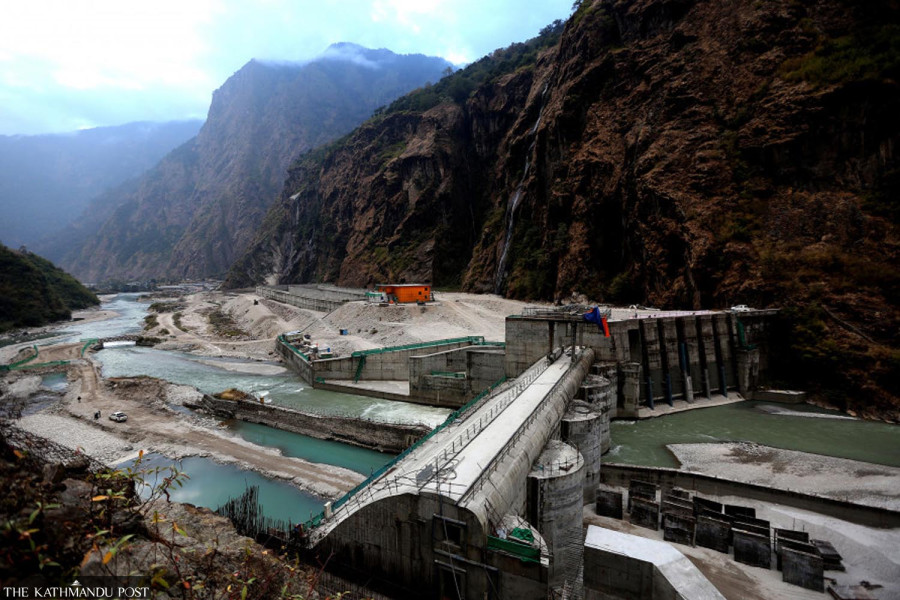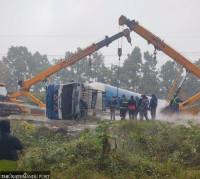National
Government mulls removing Q40 requirement for hydropower projects
Amid signs of growing market access to India, the government plans to allow developers to optimise their installed capacity enabling them to produce more in the wet season.
Prithvi Man Shrestha
With India opening its market for Nepali electricity, the government is mulling over relaxing an existing provision that requires hydropower developers to design their projects in a way so as to produce electricity in full capacity for at least 4.8 months.
Nepal’s hydropower projects—almost all of which are run of the river type—produce electricity in full capacity in the summer (wet season) while their production decreases significantly in the winter season (dry season) when water levels in the rivers decrease.
A hydropower project that can produce electricity in full capacity for 4.8 months is also known as Q40 project. Relaxation of this requirement means hydropower projects can optimise their installed capacity enabling them to produce more power in the summer when water levels in the rivers grow.
“We are studying to remove the existing Q40 requirement,” said Energy Minister Pampha Bhusal at an interaction in Kathmandu on Sunday. “We want to utilise water resources to the maximum.”
Madhu Bhetuwal, spokesperson at the Ministry of Energy, Water Resources and Irrigation, said the government plans to remove restrictions on project optimisation amid growing market for Nepal’s electricity.
India has allowed Nepal to sell 364MW of electricity through India Energy Exchange Limited, an electronic power market platform.
As per the Joint Vision Statement on Power Sector Cooperation between Nepal and India unveiled in early April, the countries will strengthen cooperation on joint development of power generation projects in Nepal, and development of cross-border transmission infrastructure and bi-directional power trade with appropriate access to electricity markets in both countries based on mutual benefits.
The two sides also agreed to expand cooperation in the power sector by including their partner countries under the Bangladesh, Bhutan, India and Nepal (BBIN) framework, subject to mutually agreed upon terms and conditions between all involved parties.
“Why not to maximise the capacity of our water resources when the market for power is growing,” said Bhetuwal. “So, we plan to allow the developers to fix their installed capacity as per their wish based on their own assessment of the markets for their power.”
Minister Bhusal said that the ministry would reach a definite conclusion on the matter very soon.
As per the Directive on Licensing Electricity Projects-2075, the hydropower plants that apply for survey licence need to be designed on the basis of Q45 (flow exceedance). “We charge a licence fee based on Q45 initially,” said Akash Shrestha, a senior divisional engineer at the department. “We have, however, been accepting Q40 projects too based on the study of the project and signing of power purchase agreement with the Nepal Electricity Authority.”
The provisions of Q40 and Q45 were included in the directives to prevent hydropower developers from optimising the capacities of their projects to their maximum, which could lead to spilling of generated electricity in the wet season. In Nepal, the demand for electricity decreases in the wet season and rises during the dry season.
“We wanted to avoid the situation where the country suffers shortage of electricity in the dry season as there are not enough storage type projects and the electricity spills in the wet season,” said Bhetuwal.
The Nepal Electricity Authority also requires developers to determine how long they can produce electricity in their full capacity and when power production will come down, to make necessary planning for electricity distribution.
“While signing the power purchase agreement, we seek to ensure that whether the project has been designed in Q40 or Q45 or other capacity,” said Suresh Bhattarai, spokesperson at the NEA. “We still may require such a provision to avoid risk of power spillage as demands in external markets can be unreliable.”




 7.12°C Kathmandu
7.12°C Kathmandu













%20(1).jpg&w=300&height=200)

